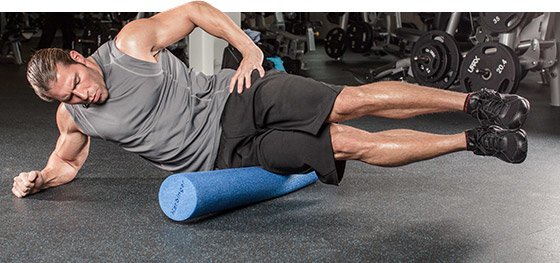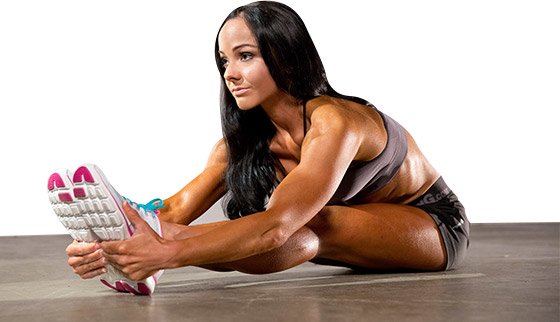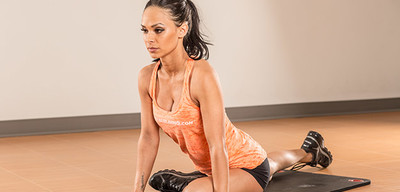Like driving, stretching, has its own set of rules for the road. Follow them closely and you'll get to your destination safe, sound, and in good shape. Neglect them, and you're on your own. Here are 18 most important tips—and what to avoid—when it comes to stretching.
The Do's
"Even doing a few static stretches at the end of a single workout will help with next-day muscle soreness so you won't be moving like a corpse."
DO use static stretching to maintain flexibility, but do it after your workout, not before. Even doing a few static stretches at the end of a single workout will help with next-day muscle soreness so you won't be moving like a corpse.
DO stretch tight muscles when training a favorite or strong body part. For instance, if your chest is strong and your calves are tight—a common scenario—stretch your calves between sets of bench presses. In order to truly increase your flexibility with stretching, you must do it often. This is one way to increase the frequency of stretching without making it a boring chore.
DO use traction when stretching to increase range of motion and reduce compression or impingement of a joint. This can be done in the gym by pulling on a resistance band attached to an immovable object like a power cage or chin-up bar. Either grab on to the band with your hand for various upper-body stretches, or hook it on to your foot or ankle for a number of lower-body options.
DO control which area of the muscle is being stretched. To stretch the hamstrings, for example, you target the muscle belly when bending the knee, rounding the back, or plantar-flexing the ankle (i.e., pointing the foot away). If you lock your knee, keep your back straight, or dorsi-flex the ankle (i.e., flex the foot toward the shin), the target instead is the fascia, the sheath that covers the muscle.
DO stretch if you have poor posture. Muscles shorten over time and can contribute to poor posture, which can also be caused by consistently training over a limited range of motion (not doing full-range reps). For example:
- Wearing high heels causes shortening of the calves because the calves are constantly in a state of nearly full contraction.
- Look at your fingers: They're always in flexion from typing, writing, eating, driving, training, etc., and tend to curl.
- Your hip flexors are considered the tightest muscle in the human body. Let's face it: The average person spends up to 40 percent of his or her life in a seated position!

DO stretch the spinal column between sets of compressive exercises such as squats and overhead presses. It's not unusual for someone to lose 20-40 millimeters of height following a weight-training session! Hanging from a chin-up bar can help a great deal with spinal decompression.
DO scan your body for tight muscles, then attack the target area by stretching. Always stretch tight muscles first as they can inhibit your ability to do full-range exercises. (Note: This is a case when dynamic stretching is done before your actual training.) During your warm-up, use general movement of all body parts to scan for tightness. Once found, use the appropriate stretching techniques to release it.
DO favor closed-chain over open-chain stretches. Most people stretch their hamstrings by throwing their heel on a bench and reaching forward to their toes, which is an open-chain stretch. Research shows closed-chain stretching results in a 5-degree increase in flexibility. Any form of stretching that exerts pressure on the soles of the feet or the palms of the hands (which closes the chain) will produce strong reflex extension, and greater range. Toe-touching stretches done in standing versus seated positions are actually different procedures to your nervous system.
DO use gentle motion for rehabilitation, but don't push the end range. For instance, the popular "mad cat" and "camel" stretches that you see people do on their hands and knees are useful for neural flossing of the spine (by getting nerves to move, they can create their own space). If you experience back pain, 5-6 cycles of these stretches prior to training may help.
DO stretch surrounding muscles to liberate greater range of motion (ROM). For instance, the iliotibial (IT) band is a dense, fibrous band of connective tissue that runs along the outside of your thighs and is very resistant to stretch. To really get at this tissue, you need to address the muscles on either side of the IT band, such as the quadriceps and hamstrings. Rolling on a foam roller can help.

The Don'ts
DON'T hold an intense stretch for longer than 15 seconds because of muscle hypoxia. Lack of oxygen to the muscles develops under a high degree of force/tension and can increase the development of connective tissue, which decreases strength and may actually promote inflexibility. It's better to use multiple angles for a short duration with static stretching rather than holding one angle for a long period of time. The rule is that the more intensive the stretching, the shorter its application.
DON'T skip strength-training exercises that promote passive stretching. These movements will result in an increase in flexibility, assuming you train using a full range of motion. Here's a list of the best choices, by body part:

- Hamstrings: Stiff-legged deadlift or good morning
- Pectorals: Flat bench dumbbell fly
- Triceps: Seated overhead triceps extension
- Biceps: Incline bench dumbbell curl
- Latissimus dorsi: Lying dumbbell pull-over
- Mid-back: Seated cable row
- Abdominals: Stability ball crunch
- Deltoids: One-arm cable lateral raise
- Gastrocnemius: Standing calf raise
- Soleus: Seated calf raise
DON'T stretch first thing in the morning, especially if you have a low back injury. Wait at least one hour after awakening. While you sleep, your spine swells with fluid, and the risk of injury is heightened if you stretch right after you wake up.
DON'T negate a stretch by contracting that muscle immediately afterward. For instance, if you grab on to an overhead bar in a power cage with one hand and sink down as far as you can by bending your knees, you'll experience a great lat stretch. But if you pull yourself back up using the same muscles you just stretched, you'll defeat the purpose. Use your legs instead to come back out of the stretch.
DON'T use static stretching on the muscles you're about to train. As I discuss in my "Warm-Up to Strength Training" DVD, this practice tends to sedate the muscles, and research shows it will decrease strength and power. Also, static stretching prior to activity may actually cause injuries, not prevent them. Although some exceptions apply for very tight muscles, for the most part you should perform static stretching after activity or exercise.

DON'T hold your breath during a stretch, as this will tense your muscles. Instead, you need to relax by exhaling longer than inhaling. Keep in mind that the opposite&mdash (hyperventilation) will excite the system. That may help before a heavy set of deadlifts, but not while you're stretching!
"Weightlifters can often squat deeper than other athletes, dispelling the myth that strength training and large muscles decrease flexibility!"
DON'T believe the myth that weight training will make you inflexible! John Grimek, a weightlifter and world-champion bodybuilder in the 1930s and 1940s, would perform back flips and splits during his posing routines. Tom Platz, a world champion bodybuilder from the 1970s and 1980s, also displayed extraordinary flexibility, considering he had arguably the best-built legs in all of bodybuilding. Platz would perform full, deep squats in training, and he was notorious for being able to not only touch his toes, but kiss his knees! That's how flexible his hamstrings were, so don't believe the hype!
Weight training will improve flexibility if you balance agonists and antagonists, and train through full range of motion. In fact, full ROM exercise tends to increase both active and passive flexibility. Flexibility is at least average or above in strength athletes such as throwers, weightlifters, gymnasts and wrestlers, which refutes the concept of being muscle-bound.
Furthermore, weightlifters can often squat deeper than other athletes, dispelling the myth that strength training and large muscles decrease flexibility! There's plenty of research to back this up.
DON'T stretch if you're already very flexible! There's really no point. If you want to relax, try a warm bath and some classical music. There's actually an inverse relationship between mobility and stability. Being extremely stiff is one thing, but going too far to the other extreme can promote joint laxity and isn't desirable. Optimal—not maximal—static and dynamic flexibility is required for each joint.
Stretch Your Growth
There's a time and place for everything, and stretching is no exception. If you follow these basic rules, you'll get the most out of your stretching effort!



